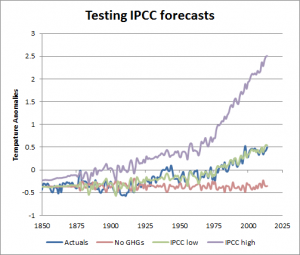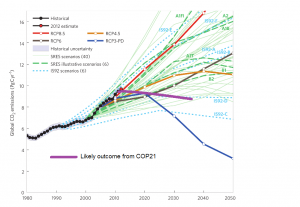In the Saturday Australian, Bjorn Lomborg set out his climate change manifesto. He asserts that the efforts coming out of COP21 to reduce global warming are a waste of money! Yet he uses IPCC nonsense to make up his own nonsense.
IPCC
Using or misusing IPCC reports, Bjorn Lomborg makes the extraordinary claim that “Achieving the 1.5C target would require ending the use of every single fossil fuel in less than four years.” If this claim has any basis in an IPCC report it would be by taking the upper estimate of the impact of greenhouse gases on global temperatures, and treating this as the final and likely result.
The IPCC provides some sensible and some “silly” estimates of the impact of greenhouse gases. One of these “silly” estimates means that at around 450 ppm of atmospheric CO2 the average global temperature will increase by 4.5C over pre-industrial averages. However, that is the upper level of their estimates. The bottom of the range shows that at around 450 ppm of atmospheric CO2 the global average temperature will increase by only 1.5C. This lower number is actually based on the empirically observed level – the IPCC only included that bottom element of the range because the evidence pointed so strongly to this fact. (Protests followed immediately upon the release of the 2016 IPCC report (the latest), arguing that the authors had conceded too much to the empirical evidence and their “hotter models” still held up satisfactorily.)

Bjorn Lomborg seems to have taken the IPCC’s bogus upper range “prediction” and used it as a linchpin for his proposition. (He should retire from pretending to contribute to scientific debate and start writing fiction. They same fate should await the IPCC if they can’t get their act together and start dealing with the evidence in a meaningful way.)
A rational argument from the latest IPCC report is that the world should at least be targeting a limit on atmospheric CO2 of 450 ppm. This is a feasibly achievable level, and one that was implicitly accepted in the Paris Climate Change conference of 2016 – COP21.
COP21
Bjorn Lomborg claims that the “Paris Agreement doesn’t stand scrutiny.” It seems to be that the COP21 agreement can withstand closer scrutiny than his wild assertions.
In Paris, the EU, USA and other developed nations, including Australia pledged to cut emissions by around 1% a year from now until 2030. The missing element was China, which pledged to keep increasing CO2 emissions until 2030 despite being the world’s largest emitter of CO2. In this, President Xi was supported by President Obama, despite the obvious disastrous consequences for the world climate if China delivered on its “promise,” and despite the political odium it has brought to his side of politics.
China’s political games (and Obama’s folly) are annoying and do not contribute constructively to the dialogue. Yet the evidence currently points to China actually cutting its coal usage, so all is not lost, despite the failure of Bjorn Lomborg to notice this development. In fact, there have been strong indications that China has been cutting its CO2 emissions since late 2013, when they appear to have reached their peak. However, on this the jury must still remain out, since China operates in an excessively opaque manner.
COP21 did not deliver the final solution to the problem of CO2 and N2O emissions, but it set in place a framework for further such emissions to be achieved. A “final solution” is still awaiting a new realistic technical and financially viable solution, assuming that a wider uptake of uranium-based nuclear power remains unacceptable in most democratic nations.
Just because a “final solution” has not been developed, there is a good case can be made that the nations of the world should do much as they can reasonably do in the meantime. This is because once CO2 is pushed into the atmosphere it remains in the CO2 cyclic bank, and unless a way of removing it naturally or technologically can be developed, it will continue its warming influence.
It was neither rational nor honest for Bjorn Lomborg to characterise COP21 as a failure. It was in fact the most successful such meeting to date, and points the way to a successful resolution of currently very difficult problem of growing atmospheric levels of CO2. Although it was an “interim solution” it was a useful one, and one that fits in with his own emphasis on finding a technological solution to energy creation. It does this without unnecessarily adding to the “atmospheric carbon bank.”

Journal Nature
Bjorn Lomborg also retreats into the sophistry produced by the prestigious journal Nature, which he cites as saying, “No major country is on track to meet its pledges.”
This journal is on a path to beat up climate change as its new reason to exist. Their claim is the kind of nonsense that Bjorn Lomborg seems to like, since in his citation there is no acknowledgement of the technological changes that are being continually developed. Even in Australia, moves have been made to make intermittent wind power more viable by introducing storage via its Snowy Mountains mark 2.0 proposal. This will make a very significant contribution, despite the scepticism shown by those who don’t understand either variable electrical demand or pricing theory.
Despite concluding his article with a plea for money to be spent on research on developing more effective low-carbon electricity generating facilities, in his role as an advocate for his own position, he did not think it worthwhile to debunk Nature‘s misleading claim, based on his own work, but rather misused it for his own advocacy.
When, oh when, will climate change debate be more mature? Propositions are put up in prestigious journals that should not appear in this naked and misleading form, and university professors write misleading articles. These are matters that should be able to be considered and rejected even at undergraduate level, but the lecturers and researchers are not providing their students with the tools that are required. Instead we have serious scientists and students marching “for science” to defend propositions that are easily debunked.
In the france24 piece cited earlier, Scott Pruitt, the head of the US EPA, was debunked for saying the quantum of the impact of greenhouse gases on the global warming is still being debated. Of course it is, even though the presenter thought he was talking nonsense! The IPCC has a range for “climate sensitivity” which goes from (an empirical) 1.5C to a modelled 4.5C. That means, for a CO2 level of 450 ppm (plus other greenhouses), the expected increase in global temperature since industrialisation could be in the range of +1.5C to +4.5C. Of course the impact of greenhouse gases on the environment is being debated! Scott Pruitt wants a debate on climate change. He does not meekly accept the bullying tactics of so-called “progressives,” who are always saying “accept the evidence,” when these same progressives do not understand the evidence themselves.
China is important
In 2015, China used 1,793,000 kt of coal for electricity generation, and it generated 5449 TWh of electricity. This works out to be 329 kg coal per MWh.
In 2015, USA currently consumes 656,000 kt of coal for electricity generation, and it generated 4128 TWh of electricity. This works out to be 159 kg coal per MWh. If the USA is able to achieve only a 20% cut in coal usage by 2030, that would bring down the average to 127 kg per MWh. It can be expected to do much more than that.
Obviously China and the USA have a different mix of generating infrastructures, but it is clear that China has a long way to go in reducing thermal coal consumption in order to achieve parity with the USA. In this sense, China has a bigger “legacy problem” from its existing facilities than the USA.
Even if China just achieved parity with the USA on coal usage at 127 kg per MWh by 2030, and its electricity consumption rose to 11900 TWh, that would still represent a net reduction its total coal consumption. Of course, it can do much better than that!
The next step for China is to acknowledge that it too can make a realistic contribution to the COP21 pledges, and drop its promise to keep increasing CO2 emissions out to 2030.
Pumped Hydro can’t be ignored
In writing an article for an Australian newspaper, Bjorn Lomborg has not given any consideration to the potential for pumped hydro to resolve the generation / dispatch issue associated with wind power. Yet the Australian government has commenced a major project, Snowy Mountains 2.0, to utilise the capacity of existing water storage facilities for “electricity storage.” Even if Bjorn Lomborg has ignored pumped hydro because he rejects its ability to help to solve the dispatch issue with wind power, he should have explained his objections rather than ignoring it.
Instead, he writes, “When there is no sun or wind, we must still pay for back-up fossil fuels, which now cost more because they are used less.” An omission of this significance surely vitiates his entire article, even if it were the only omission and misstatement. But it is not alone, as I have already explained.
Global Governance is not required
Bjorn Lomborg cites an early advocate of action on global warming, Jim Hanson, who is quoted as saying, “Suggesting that renewables will let us phase rapidly off fossil fuels in United States, China, India or the world as whole is almost the equivalent of believing in the Easter bunny and tooth fairy.”
It is not clear from this what Hanson thought was necessary to achieve the objective for which he aimed, but we know that the IPCC is now committed to the idea of global governance, as explained by an IPCC representative at the end of this video on France24. Apparently, the IPCC does not believe that democratic governments are up to the challenge, despite the fact the democratic governments have done more to manage emissions than non-democratic governments. As a rather wild example, India’s CO2 emissions are 1.58 tonnes per person, whereas China’s CO2 emissions have grown from 1.83 tonnes per person in 1990 to 6.58 in 2015. On the other hand, USA’s CO2 emissions have fallen from 19.20 tonnes per person in 1990 to 15.53 tonnes per person in 2015. They will continue to fall as new approaches become available and viable, as one would expect in a democratic and capitalist nation.
The success of COP21 in charting a path forward for action of climate change has not been welcomed by some climate change activists, as well as being debunked by Bjorn Lomborg. Each side has its own agenda.
Welfare Spending is a diversion
Bjorn Lomborg’s own “think tank,” the Copenhagen Consensus advocates stopping spending on CO2 emission reductions, concentrating on welfare spending and research and development. He writes, “Analysis by the Copenhagen Consensus has highlighted many phenomenal development investments where a fraction of the Paris treaty’s budget would help vulnerable communities much more today than carbon cuts would in 100 years: things such as stepping up investment in combating tuberculosis, nutritional investments for young children, vaccinations and achieving universal access to family planning.”
All of this is “more aid” gobbildy-gook, which will just keep poor nations impoverished. A realignment of trade that sees each nation becoming more self-sufficient will do more for “vulnerable communities” in every nation than the Copenhagen Consensus’ diversion of funds from fixing the problem of growing CO2 atmospheric levels.
“No Action:” big downside & little upside
If CO2 emissions were allowed to continue at the current level right up to 2100, as Bjorn Lomborg seems to prefer (if technology doesn’t come to the rescue), the CO2 in the atmosphere will increase from the current 405 ppm by 2 ppm each year for the next 80 years. That will bring the level of atmospheric CO2 up to 565 ppm. We might get better crops, but the cost of this is unpredictable.
Even if the impact does no more than reflect the historical relationship between the increases in greenhouse gas atmospheric levels and the global average temperature, this will result in the global average temperatures rising by 2.3C. If, in addition, only half the worse result of the IPCC’s models is realised, they will increase by 4.6C! What a potential legacy to leave to our grandchildren!
Bjorn Lomborg is willing to accept the view that “climate change will cause hurricanes to become somewhat stronger but also less frequent.” He offsets this by arguing that since nations are becoming wealthier they can repair the damage more easily. However, this is a nice argument for Denmark, but I am not so convinced it works for Haiti, San Marie and the Dominican Republic, or even for the poorer parts of the United States.
COP21 was a fair result and a good model. If China would come on board, it will be a really good result. Bjorn Lomborg is not helping!
